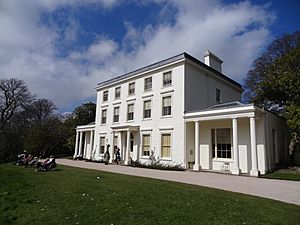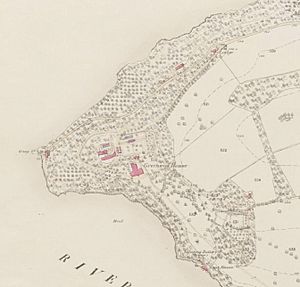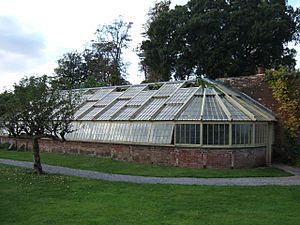Greenway Estate facts for kids
Quick facts for kids Greenway House |
|
|---|---|
 |
|
| Type | House |
| Location | Galmpton, Devon |
| Built | c. 1780 |
| Architectural style(s) | Georgian |
| Governing body | National Trust |
|
Listed Building – Grade II*
|
|
| Official name: Greenway House | |
| Designated | 21 May 1985 |
| Reference no. | 1108548 |
| Official name: Greenway | |
| Type | Grade II |
| Designated | 3 March 2004 |
| Reference no. | 1001686 |
| Lua error in Module:Location_map at line 420: attempt to index field 'wikibase' (a nil value). | |
Greenway, also known as Greenway House, is a beautiful estate located on the River Dart in Devon, England. It was once the beloved home of the famous mystery writer Agatha Christie. Today, the National Trust looks after it, and you can visit it!
Greenway was once connected by the Dartmouth Steam Railway. Trains from Paignton and Kingswear used to stop at Greenway Halt. However, trains have not stopped there since March 2020.
Contents
A Look Back: The History of Greenway House
Greenway has a long and interesting past, stretching back hundreds of years.
Greenway's Early Days: Before 1938
Greenway sits on the eastern side of the River Dart. It faces the village of Dittisham across the water. The estate is about two miles from Galmpton, the closest village. People have described Greenway as a "very pleasant" place with lovely views of boats on the river.
The name "Greynway" first appeared in records in 1493. It was a crossing point for the Dart River to Dittisham. In the late 1500s, a large Tudor mansion called Greenway Court was built. It belonged to Otto and Katherine Gilbert, a family known for their seafaring adventures. They likely kept their ships, like The Hope of Greenway, moored in the river nearby.
The Gilberts had three sons who were all born at Greenway. One son, Sir Humphrey Gilbert, claimed Newfoundland for Queen Elizabeth I in 1583. His brother, Sir John Gilbert, lived at Greenway. Their half-brother, Sir Walter Raleigh, also spent time at the house. In 1588, after the Spanish Armada, John Gilbert was in charge of 160 prisoners of war. He made them work on the estate, helping to level the grounds.
We don't know much about the original Tudor house. But because the Gilberts were important, it was probably very grand. You can still see parts of the old Tudor courtyard under the current house's hallway. At low tide, you can also spot parts of the Tudor slipway from the boathouse.
Around 1700, the Gilbert family moved to Compton Castle. They sold Greenway to Thomas Martyn. Over the next 90 years, the house changed hands a few times within related families. A man named Roope Harris Roope built the current house in the Georgian style. He sold Greenway in 1791.

The Elton family bought Greenway and worked on developing the garden. Some changes were made by the famous landscape gardener Humphry Repton. The old Tudor house was completely taken down around this time. Edward Elton's son, James, took over in 1811. He made the house bigger by adding two wings for a dining room and drawing room. He also paid for a new road to the Greenway ferry. When he sold the estate in 1832, it had a large kitchen garden, a swimming pool, a boathouse, and newly designed gardens.
Colonel Edward Carlyon bought Greenway in 1832. His family owned Tregrehan House in Cornwall. The Carlyons didn't change the inside of the house much. But they probably added a rockery (a garden feature with rocks) to the slope on the east side of the house.
Colonel Carlyon moved to Tregrehan House in 1843. Greenway was then rented out to several people. Later, it was sold to Richard Harvey, a wealthy copper and tin businessman from Cornwall, and his wife Susannah. The Harveys greatly improved the estate. They fixed up the stables and lodge house, added two new greenhouses, and redecorated the inside. They also helped improve the village of Galmpton, building the village school and the Manor Inn.
Richard Harvey passed away in 1870, and his wife in 1882. They had no children, so the estate was sold to Thomas Bedford Bolitho. Bolitho was a Member of Parliament. He added a "Cornish influence" to the gardens. He brought in plants like camellias, magnolias, rhododendrons, and laurels. In 1892, he built a new east wing for the house. This wing had a billiard room, a study, and bedrooms. However, this part was removed in 1938.
Bolitho died in 1919, and his daughter Mary and her husband, Charles Williams, took over. They added many new types of plants from nurseries in Cornwall. In 1937, they moved back to Cornwall and sold the estate to Alfred Goodson. He then divided the estate and sold off parts of it in 1938. The house, with about 36 acres of land, was then put up for sale.
Agatha Christie's Home: From 1938 Onwards
In 1938, the famous writer Agatha Christie and her husband, the archaeologist Max Mallowan, were looking for a new home. They were not happy with their house in nearby Torquay anymore. The town had changed, and new buildings blocked their sea view. As Christie looked around south Devon, she saw Greenway was for sale. She had known the property since she was young and always thought it was "the most perfect" house on the Dart River.
She wrote in her autobiography: "One day we saw that a house was up for sale that I had known when I was young... So we went over to Greenway, and very beautiful the house and grounds were. A white Georgian house of about 1780 or 90, with woods sweeping down to the Dart below, and a lot of fine shrubs and trees – the ideal house, a dream house."
Agatha Christie and Max Mallowan lived in Greenway until their deaths in 1976 and 1978. The house appeared in many of Christie's mystery novels, sometimes under different names. Christie's daughter, Rosalind Hicks, and her husband, Anthony, lived in the house from 1968 until Rosalind's death in 2004.
The National Trust bought the Greenway Estate in 2000. They recognized its importance as a writer's home. On May 21, 1985, Greenway House was given a Grade II* listed building status by English Heritage (now Historic England). This means it's a very important historic building. The Pevsner guide describes it as a "tall, late-Georgian, stuccoed" house. The gardens and parkland are also listed as Grade II on the National Register of Historic Parks and Gardens.
Today, the house and gardens are open to the public. You can also visit the Barn Gallery, which shows art by local artists. The large gardens by the river have many plants from the southern hemisphere.
Greenway in Agatha Christie's Books
Agatha Christie often used places she knew well as settings for her stories. Greenway Estate and its surroundings appear in several of her famous novels:
- The A.B.C. Murders (1936)
In this book, a character named Sir Carmichael Clarke lives in Churston, which is close to Greenway. Churston is also a station on the steam railway line, just before Greenway Halt.
- Five Little Pigs (1942)
The main house, the path leading to the battery (a small fort) overlooking the Dart River, and the battery itself are all described in great detail. These locations are very important to the story and how the mystery is solved.
- Towards Zero (1944)
The location of the estate, across the River Dart from Dittisham village, is key to a character's alibi and a nighttime swim.
- Dead Man's Folly (1956)
The boathouse at Greenway Estate is where the first victim is found. A nearby ferry landing is where another victim is pulled into the water. Other places described include the greenhouse and the tennis court. The lodge at Greenway Estate is the home of Amy Folliat, a former owner of Nasse House in the story.
Greenway's house and gardens are also used in Agatha Christie's short story 'The Shadow on the Glass'. This story is part of the collection The Mysterious Mr Quin, which was first published in 1930. This was eight years before she even bought the estate!




